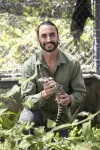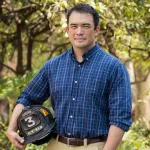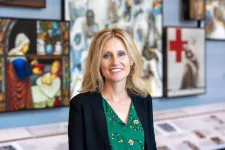(Press-News.org) Invasive species in Florida like Nile monitors and Argentine black-and-white tegus pose a growing threat to the Sunshine State’s environment, economy and public safety. South Florida’s warm climate, disturbed habitats and bustling pet trade have made it a hotspot for these non-native, cryptic reptiles. However, finding these elusive creatures has always been a challenge – until now.
University of Florida researchers are showcasing how a focused outreach initiative in Palm Beach County has led to a successful increase in reports of invasive reptiles in Florida. The findings are documented in the latest study published in Scientific Reports and authored by researchers at UF/IFAS Fort Lauderdale Research and Education Center.
This initiative addresses the growing threat posed by non-native reptiles to the environment, economy and public health in South Florida.
“When species are rare and hard to find, it helps to get a lot of eyes looking for them. Targeted outreach does that,” said Frank Mazzotti, professor of wildlife ecology and lead author of the study. “Community involvement not only proves to help us find invasive species but provides opportunities to increase awareness as well.”
Targeted outreach involves delivering specific messages to audiences in designated locations to achieve desired outcomes. In this case, the goal was to encourage residents and workers in the C-51 Basin and surrounding areas in Palm Beach County to report sightings of large invasive lizards, such as Nile monitors, to the Florida Fish and Wildlife Conservation Commission (FWC) IVE-GOT1 hotline or through EDDMapS.
EDDMapS is a website that maps the distribution of non-native species in the United States and Canada through documented reporting provided by experts and the general public throughout those two countries.
From 2018 to 2020, the project’s targeted outreach efforts reached over 112,000 people and households through various methods including in-person, online and virtual.
Subsequently, researchers engaged 53,657 people on social media, presented webinars to 229 individuals, sent email newsletters to 34,350 recipients, conducted an online survey with 520 participants and potentially reached up to 20,000 people through print media.
These efforts led to 55 reported sightings of Nile monitors and Argentine black and white tegus in Palm Beach County and the surrounding area, with 32 of these reports directly attributed to UF/IFAS’ outreach.
The data gathered by the project showed that newspapers brought in the most reports, helping UF/IFAS researchers identify more invasive reptiles. In-person methods, such as door hangers and presentations allowed for face-to-face engagement, making residents feel more confident in reporting what they spotted. Social media proved to be a time-efficient way to spread the message far and wide, allowing even more people to become part of the effort.
“We learned valuable lessons regarding the effectiveness of different targeted outreach methods for detection of invasive wildlife,” said Mazzotti. “Targeted outreach can be done by a broad community of environmental educators. These methods can be replicated in other locations with different target species, which could lead to an increase in local understanding of the status and range of invasive species in Florida, and ultimately improved management and monitoring programs.”
Invasive species in Florida like Nile monitors and Argentine black-and-white tegus pose a growing threat to the Sunshine State’s environment, economy and public safety. South Florida’s warm climate, disturbed habitats and bustling pet trade have made it a hotspot for these non-native, cryptic reptiles. However, finding these elusive creatures has always been a challenge – until now.
University of Florida researchers are showcasing how a focused outreach initiative in Palm Beach County has led to a successful increase in reports of invasive reptiles in Florida. The findings are documented in the latest study published in Scientific Reports and authored by researchers at UF/IFAS Fort Lauderdale Research and Education Center.
This initiative addresses the growing threat posed by non-native reptiles to the environment, economy and public health in South Florida.
“When species are rare and hard to find, it helps to get a lot of eyes looking for them. Targeted outreach does that,” said Frank Mazzotti, professor of wildlife ecology and lead author of the study. “Community involvement not only proves to help us find invasive species but provides opportunities to increase awareness as well.”
Targeted outreach involves delivering specific messages to audiences in designated locations to achieve desired outcomes. In this case, the goal was to encourage residents and workers in the C-51 Basin and surrounding areas in Palm Beach County to report sightings of large invasive lizards, such as Nile monitors, to the Florida Fish and Wildlife Conservation Commission (FWC) IVE-GOT1 hotline or through EDDMapS.
EDDMapS is a website that maps the distribution of non-native species in the United States and Canada through documented reporting provided by experts and the general public throughout those two countries.
From 2018 to 2020, the project’s targeted outreach efforts reached over 112,000 people and households through various methods including in-person, online and virtual.
Subsequently, researchers engaged 53,657 people on social media, presented webinars to 229 individuals, sent email newsletters to 34,350 recipients, conducted an online survey with 520 participants and potentially reached up to 20,000 people through print media.
These efforts led to 55 reported sightings of Nile monitors and Argentine black and white tegus in Palm Beach County and the surrounding area, with 32 of these reports directly attributed to UF/IFAS’ outreach.
The data gathered by the project showed that newspapers brought in the most reports, helping UF/IFAS researchers identify more invasive reptiles. In-person methods, such as door hangers and presentations allowed for face-to-face engagement, making residents feel more confident in reporting what they spotted. Social media proved to be a time-efficient way to spread the message far and wide, allowing even more people to become part of the effort.
“We learned valuable lessons regarding the effectiveness of different targeted outreach methods for detection of invasive wildlife,” said Mazzotti. “Targeted outreach can be done by a broad community of environmental educators. These methods can be replicated in other locations with different target species, which could lead to an increase in local understanding of the status and range of invasive species in Florida, and ultimately improved management and monitoring programs.”
END
Researchers’ new outreach strategy succeeds, sets blueprint for detecting invasive species in Florida
2024-10-28
ELSE PRESS RELEASES FROM THIS DATE:
Discovery of critical iron-transport protein in malaria parasites could lead to faster-acting medications
2024-10-28
Malaria kills over 600,000 people a year, and as the climate warms, the potential range of the disease is growing. While some drugs can effectively prevent and treat malaria, resistance to those drugs is also on the rise.
New research from University of Utah Health has identified a promising target for new antimalarial drugs: a protein called DMT1, which allows single-celled malaria parasites to use iron, which is critical for parasites to survive and reproduce.
The results suggest that medications that block DMT1 might be very effective against malaria.
The new results are published in PNAS.
An ironic mystery
Paul Sigala, ...
Risky choices: How US laws affect migrant children’s journeys to border
2024-10-28
U.S. immigration law and the legal categorizations it imposes on migrants shape the journeys of migrant children from Central America as they move through Mexico toward the southern U.S. border, according to a new Yale study.
In the study, sociologist Ángel Escamilla García documents the various hard decisions Central American youth are forced to make during their journeys to maximize their chances of not being deported once they reach the United States. Those choices include concealing sexual assaults, beatings, and other crimes ...
Scientists address risks to supply chain in a connected world
2024-10-28
RICHLAND, Wash.—Scientists are gathering at the Department of Energy’s Pacific Northwest National Laboratory this week for a first-ever conference to consider ways to protect critical systems such as our electrical grid, water treatment plants and financial networks that are vulnerable in new ways.
The Cyber Supply Chain Risk Management Conference, known as CySCRM 2024, is being held on the PNNL campus Tuesday-Wednesday, Oct. 29-30.
It’s a new kind of science meeting, one that scientist Jess Smith and colleagues felt compelled to create as they eye a new kind of risk—a ...
Don’t skip colonoscopy for new blood-based colon cancer screening, study concludes
2024-10-28
Newly available blood tests to screen for colorectal cancer sound far more appealing than a standard colonoscopy. Instead of clearing your bowels and undergoing an invasive procedure, the tests require only a simple blood draw. But are the tests effective?
A study led by researchers at Stanford Medicine concluded that the new tests are ideal for people who shy away from other colorectal cancer screening. However, if too many people who would have undergone colonoscopies or stool-based tests switch to the blood tests, colorectal cancer death rates will rise. Because the more established colonoscopies and stool tests ...
Up to half of Medicare beneficiaries lack financial resources to pay for a single hospital stay
2024-10-28
Embargoed for release until 5:00 p.m. ET on Monday 28 October 2024
@Annalsofim
Below please find summaries of new articles that will be published in the next issue of Annals of Internal Medicine. The summaries are not intended to substitute for the full articles as a source of information. This information is under strict embargo and by taking it into possession, media representatives are committing to the terms of the embargo not only on their own behalf, but also on behalf of the organization they represent. ...
Chemicals produced by fires show potential to raise cancer risk
2024-10-28
Derek Urwin has a special stake in his work as a cancer control researcher. After undergraduate studies in applied mathematics at UCLA, he became a firefighter. His inspiration to launch a second career as a scientist was the loss of his brother, Isaac, who died of leukemia at only 33 despite no history of cancer in their family. Working with Anastassia Alexandrova, a professor of chemistry and biochemistry in the UCLA College, he earned his doctorate.
Urwin is now a UCLA adjunct professor of chemistry — and still a full-time firefighter with the Los Angeles County Fire Department. In a recent publication, his science shed new light on the chemical underpinnings of exposures ...
Penn Nursing awarded $3.2 million grant to improve firearm safety
2024-10-28
PHILADELPHIA (October 28, 2024) – The University of Pennsylvania School of Nursing (Penn Nursing) has been awarded a $3.2 million, 5-year grant from the National Institute of Nursing Research (NINR) to scale out an evidence-based secure firearm storage intervention at Children’s Hospital of Philadelphia (CHOP). Firearms are now the leading cause of death for U.S. children and teens, driving the largest spike in children’s mortality in more than 50 years. The study aims to keep children safer from firearm injury and mortality by promoting secure firearm storage.
The intervention, ...
Bird wings inspire new approach to flight safety
2024-10-28
Taking inspiration from bird feathers, Princeton engineers have found that adding rows of flaps to a remote-controlled aircraft’s wings improves flight performance and helps prevent stalling, a condition that can jeopardize a plane’s ability to stay aloft.
“These flaps can both help the plane avoid stall and make it easier to regain control when stall does occur,” said Aimy Wissa, assistant professor of mechanical and aerospace engineering and principal investigator of the study, published in the Proceedings ...
Global fleet of undersea robots reveal the phytoplankton hidden beneath the ocean's surface
2024-10-28
Marine phytoplankton are fundamental to Earth’s ecology and biogeochemistry. Our understanding of the large-scale dynamics of phytoplankton biomass has greatly benefited from, and is largely based on, satellite ocean color observations from which chlorophyll-a (Chla), a commonly used proxy for carbon biomass, can be estimated. However, ocean color satellites only measure a small portion of the surface ocean, meaning that subsurface phytoplankton biomass is not directly monitored. Chla is also an imperfect ...
Climate, dead zones and fish: Solving a 'wicked problem' in Lake Erie and beyond
2024-10-28
Images
There's a famous piece of advice from hockey, attributed to Wayne Gretzky, about how it's better to skate to where the puck is headed rather than where it is.
Research is now showing that regulations designed to protect Lake Erie's water quality are heeding the Great One's words when it comes to safeguarding the Great Lake's fisheries.
Specifically, the currently recommended limits on the flow of nutrients into Lake Erie from agriculture may be too restrictive for some species of fish. They are, however, suited to maintain healthy fisheries until the ...







